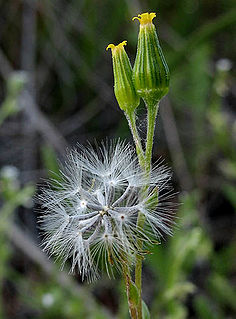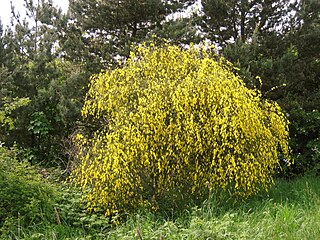
Coreopsis calliopsidea is a species of flowering plant in the daisy family known by the common name leafstem tickseed. It is endemic to California. The plant grows in some of the southern coastal mountain ranges and Transverse Ranges and the Mojave Desert from Alameda and Inyo Counties south to Riverside County.

Chaenactis artemisiifolia, with the common name white pincushion, is a species of flowering plant in the daisy family. It is native to the coastal Peninsular Ranges of Southern California and Baja California, in the chaparral and woodlands.
Lessingia arachnoidea is a rare species of flowering plant in the daisy family known by the common name Crystal Springs lessingia. It is endemic to California, where it is known from a few occurrences in the vicinity of Crystal Springs Reservoir on the San Francisco Peninsula. It may also exist in Sonoma County to the north. The plant grows in chaparral, scrub, and other local plant communities, often on serpentine soils. This is an annual herb producing a slender, erect stem up to 80 centimeters in maximum height. It is woolly toward the ends of the stems, less so toward the base of the plant. The leaves are narrow and sometimes toothed, the lowest approaching 11 centimeters long and the uppermost reduced in size. The inflorescence is made up of a single flower head at the tip of the slender stem. The flower head is lined with tiny lance-shaped phyllaries with purplish pointed tips and sometimes a coat of woolly fibers. The head is discoid, lacking ray florets but bearing several funnel-shaped lavender disc florets with raylike lobes. The fruit is an achene with a very hairy hard body 2 or 3 millimeters long and a small, bristly pappus on top.
Lessingia hololeuca is a species of flowering plant in the daisy family known by the common name woollyhead lessingia.
Lessingia tenuis is a species of flowering plant in the daisy family known by the common name spring lessingia. It is endemic to California, where it is known from the San Francisco Bay Area to Ventura County. It grows on the slopes of the California Coast Ranges in common local habitat such as chaparral.
Kyhosia is a monotypic genus of flowering plants in the aster family containing the single species Kyhosia bolanderi, which is known by the common names Bolander's madia and kyhosia.

Madia exigua is a species of flowering plant in the aster family known by the common names small tarweed and threadstem madia.
Pseudobahia bahiifolia is a rare species of flowering plant in the aster family known by the common name Hartweg's golden sunburst.
Pyrrocoma carthamoides is a species of flowering plant in the aster family known by the common name largeflower goldenweed. It is native to western North America from British Columbia to northeastern California to Wyoming, where it is known from grassland, woodlands, forests, barren areas, and other habitat. It is a perennial herb growing from a taproot and producing one or more stems to about half a meter in maximum length, the stems reddish-green and leafy. The largest leaves are at the base of the stem, measuring up to 20 centimeters long, lance-shaped with spiny sawtoothed edges. Leaves higher on the stem are smaller and hairier. The inflorescence is a single flower head or a cluster of up to four. Each bell-shaped head is lined with phyllaries each up to 2 centimeters long. It has many yellow disc florets surrounded by a fringe of yellow ray florets up to 7 millimeters long; ray florets are occasionally absent. The fruit is an achene which may be well over a centimeter in length including its pappus.
Raillardella argentea is a species of flowering plant in the aster family known by the common name silky raillardella. It is native to the Sierra Nevada and nearby mountain ranges of California, its distribution extending east into Nevada and north along the Cascade Range and Klamath Mountains into Oregon. It grows in many types of dry, open mountain habitat. It is a rhizomatous perennial herb growing in a clump of rosetted basal leaves. The leaves are lance-shaped, up to 8 centimeters long, and coated in silky hairs. The plant produces an inflorescence up to about 15 centimeters tall consisting of a solitary flower head which is cylindrical to somewhat bell-shaped. The head is enclosed in the fused outer scales of the flowers, which look similar to the phyllaries of many other species' flower heads. The head contains many yellow disc florets up to a centimeter long each, and no ray florets. The fruit is a long, narrow achene which may be 2 centimeters in length including its plumelike pappus.

Saussurea americana is a species of flowering plant in the aster family known by the common name American saw-wort. It is native to northwestern North America from Alaska to far northern California to Montana, where it grows in mountain habitat, such as meadows and forests. It is a perennial herb producing one or more hairy, glandular, erect stems up to a meter tall or more from a thick caudex. The lance-shaped leaves are up to 15 centimeters long and have toothed edges, especially the larger lower leaves. The inflorescence is a cluster of several flower heads, each a bullet-shaped body covered in purple or purple-tinged green phyllaries. The head opens at the tip to bloom with several white to purple tubular disc florets; there are no ray florets. The fruit is an achene tipped with a pappus, the whole unit sometimes exceeding a centimeter in length.

Senecio aphanactis, known by the common names chaparral ragwort, rayless ragwort, and California groundsel, is a species of flowering plant in the aster family.
Senecio aronicoides is a species of flowering plant in the aster family known by the common name rayless ragwort. It is native to Oregon and northern and central California, where it can be found in the woodlands and forests of mountains and foothills, often in relatively dry habitat. It is a biennial or perennial herb growing up to about 90 centimeters tall from a fleshy root attached to a buttonlike caudex. The plant is often slightly woolly or cobwebby in texture. The leaves have lance-shaped to oval blades measuring up to 20 centimeters long, the largest ones lower on the stem. The inflorescence is a corymb which is flat and spreading, often resembling an umbel. The flower heads are cups lined with black- or green-tipped phyllaries and filled with many gold disc florets. There are usually no ray florets but one or two occasionally emerge from a head. The fruit is a hairless achene tipped with a pappus of long, white bristles.
Senecio hydrophiloides is a species of flowering plant in the aster family known by the common names tall groundsel and sweet marsh ragwort. It is native to western North America from British Columbia and Alberta to northern California to Utah, where it grows in wet meadows and similar habitat. It is a biennial or perennial herb producing a single erect stem or a cluster of a few stems which may exceed one meter in maximum height. The plants are green to red in color and usually without hairs, but new growth can be woolly. The leaves are lance-shaped to oval with toothed edges, the blades up to 25 centimeters long and borne on long winged petioles. The leaves are firm and sometimes a bit fleshy. The inflorescence is a loose or dense cluster of up to 30 or more flower heads lined with black-tipped phyllaries. They contain many yellowish disc florets at the center and often have some yellow ray florets, though these are sometimes absent.
Packera indecora is a species of flowering plant in the aster family known by the common names elegant groundsel and rayless mountain ragwort. It is native to northern North America including most of Canada and sections of the northernmost United States. It grows in moist mountain habitat, such as streamsides and meadows.
Townsendia leptotes is a species of flowering plant in the aster family known by the common names common Townsend daisy and slender townsendia. It is native to the western United States, where it grows in the alpine climates of high mountain ranges from California to Montana to New Mexico.

Urospermum picroides is a species of flowering plant in the aster family known by the common name prickly goldenfleece. It is native to Eurasia and it is known as an introduced species in many other regions, including North and South America, Australia, and southern Africa. It grows as a common weed in disturbed habitat. This annual herb grows up to 30 to 50 centimeters tall. It is coated in long hairs and bristles. The bristly leaves are variously shaped, often divided into many sharp-toothed lobes. The inflorescence bears flower heads on thick peduncles. The head is 1 to 2 centimeters long or more and filled with yellow ray florets. It is enveloped in several pointed phyllaries which are covered in bristly hairs. The fruit is an achene well over a centimeter in length which is tipped with a pappus of bristles.

Wyethia angustifolia is a species of flowering plant in the aster family known by the common names California compassplant and narrowleaf mule's ears. It is native to the west coast of the United States from Washington to California, where it grows in grassland, meadows, and other open habitat. It is a perennial herb growing from a tough taproot and caudex unit and producing a stem 30 to 90 centimeters tall. The leaves have lance-shaped blades up to 50 centimeters tall. The inflorescence produces one or more large sunflower-like flower heads at the top of the hairy stem. The head has narrow, hairy phyllaries at the base. It contains up to 21 yellow ray florets each up to 4.5 centimeters long and many yellow disc florets. The fruit is an achene which may be nearly 2 centimeters long including its pappus.
Agnorhiza ovata is a species of flowering plant known by the common name southern mule's ears. It is native to the mountains and foothills of southern California and Baja California, occurring the Coast Ranges and Sierra Nevada foothills in Tulare, Kern, Ventura, Los Angeles, Orange, Riverside, and San Diego counties in California, with additional populations in the Peninsular Ranges south of the international border.

Cirsium parryi, or Parry's thistle, is a species of North American flowering plants in the aster family. It is native to the southwestern United States, where it has been found in Colorado, Arizona, and New Mexico.













